Bottega is a responsive and fully customizable studio/agency portfolio WordPress theme. This theme’s unique layout and expressive animations will help you build credibility in your industry.
Learn how you can get the most out of the theme with the Bottega WordPress theme documentation.
Bottega WordPress theme documentation, step 1: Theme specifications
- Recommended logo size is 210 x 40px.
- Post featured image recommended width should be 830px.
- Post content maximum width is 830px.
- Portfolio image recommended size is 1920x1080px.
Bottega WordPress theme documentation, step 2: Theme installation
The theme can be installed through the WordPress Admin panel.
- Log in to the WordPress Admin panel.
- Go to Appearance -> Themes.
- Click on the Add New button, at the top of the screen.
- In Add Themes screen, click on Upload Theme.
- Click on Choose theme, and then browse for theme file on your computer.
- Click on Install Now to start the install process.
- After the installation is done, click on Activate theme.
A detailed video for theme installation is available here: https://help.themeskingdom.com/how-to-install-and-setup-the-theme.
After activating the theme, you will be prompted to install the required plugins. Required plugins in the Bottega WordPress theme documentation are:
Bottega WordPress theme documentation, step 3: Theme demo
To set the theme as presented in our demo, you can import the demo file.
Bottega WordPress theme documentation, step 4: Theme setup
Bottega theme is a great choice for promoting your portfolio work, especially if you rely on strong visual elements.
In our demo, we have displayed chosen portfolio items on the homepage, and the rest of the work is displayed on the Work page.
To set up the theme, please follow the next steps:
- First, go to Pages -> Add New, and create four pages – Home, News, Work, and Info. For Home and News pages, set the Default page template; for Work page, select the Portfolio page template and for the Info page, select the Info page template.
- The Info page is built using an HTML block to make the image show on hover and two columns block for the text. Please refer to the Useful CSS classes section for the instructions on how to make an image appear on hover. Set the featured image for the Info page.
- Go to Settings -> Reading. Select the homepage to display a static page. For the Homepage, set the Home page, and for the Posts page, set the News page.
- Now, it’s time to add some portfolio items which will be displayed on the homepage. Go to Portfolio -> Add New. Create several portfolio items. For each portfolio item, enter the title, and set a featured image. If you need to include additional images into your portfolio, you can insert them into the content. Additional images will be displayed as a slider on the single portfolio page. Tag the desired portfolio items with the tag “Slider” – this tag will be used to display them on the homepage slider.
- Creating primary and social menu: Go to Appearance -> Menus. Create a new menu with title e.g. Primary. Add all your pages to it, and mark it as a Primary. Add your projects and pages to the navigation. In our demo, the top item is the Work page with projects as subitems, and the Info as the second top item. Create another menu but with the title Social. Add links to your social profiles as Custom Link items, and mark it as a Footer menu.
- Finally, you’ll need to add some personal touch to the theme. Go to Appearance -> Customize.
- Site Identity: Leave site logo, title, and tagline empty. Set only site icon.
- Widgets: Add three widgets – Text, Categories, and Pages. Into the Text widget, enter the short description of your site. Categories and Pages are widgets that will display a list of your categories and pages.
- Featured Content: Enter the tag (“Slider”) used for the desired portfolio items to be displayed on the homepage slider.
- Under Theme Options -> Layout Settings enable Blog Post Single: Display media in separate block and Show form buttons with animated arrows and without borders.
If you want to customize the theme a bit more, be sure to follow the next steps.
Bottega WordPress theme documentation, step 5: The Customizer
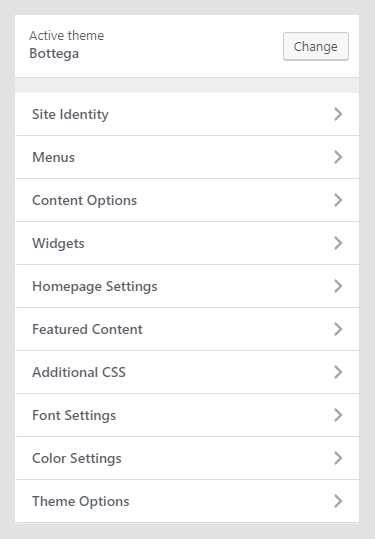
The Customizer in the Bottega WordPress theme documentation allows you to modify theme visuals and settings easily. Here are the customization options in the Bottega theme:
- Site Identity
- Menus
- Content Options
- Widgets
- Homepage Settings
- Featured Content
- Additional CSS
- Font Settings
- Color Settings
- Theme Options
Site Identity
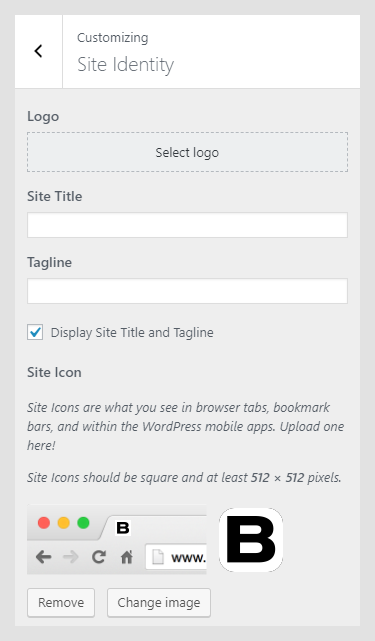
The Site Identity panel is used for setting up basic site identity:
- Logo: Site logo is an image in a .jpg, .jpeg or .png format. Suggested logo image size is 210 x 40px.
- Site Title: The name of your site. Ideal length should not exceed 20 characters. If the site title is longer, it will be displayed in two (or more) lines.
- Tagline: Tagline is a short description of the site, or simply a punchline of your business.
- Title and Tagline Visibility: If Display Site Title and Tagline is checked, both Site Title and Tagline will be displayed.
- Site Icon: Site Icon will be displayed in a browser tab, bookmarks or in the WordPress mobile app. The icon should be squarely-shaped, and the recommended icon size is 512 x 512px.
Menus
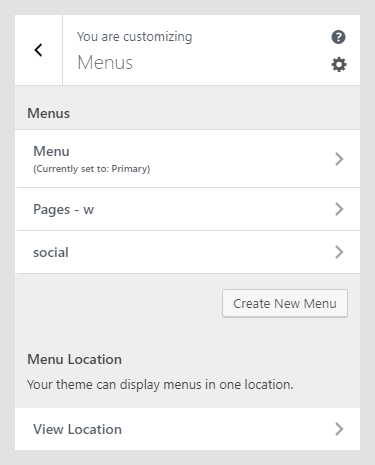
The Customizer menu option allows the user to manage available menu locations, and add and remove menu items. Bottega theme has two menu locations available – the Header menu, which is mostly used as a Primary menu, and the Social menu. Menus can be managed from Appearance -> Menus, as well.
Content Options
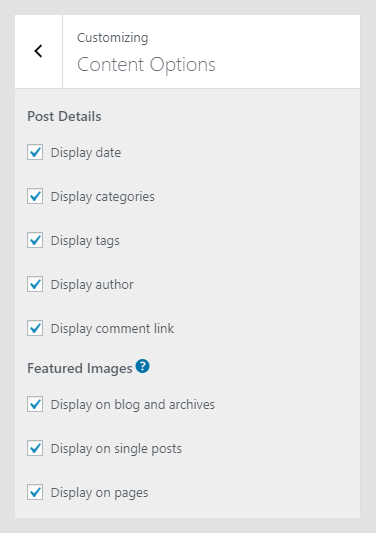
The Content Options panel in the Bottega WordPress theme documentation allows you to control the visibility of the posts’ metadata. By enabling or disabling the options, you can show or hide dates, categories, tags, and the author for all posts. Besides that, you can control where the featured image will appear. Featured images for posts and portfolios can be enabled or disabled on archives, blog pages, single posts. That way, you can set a featured image to be visible on posts page, but hidden on the single post page.
Widgets
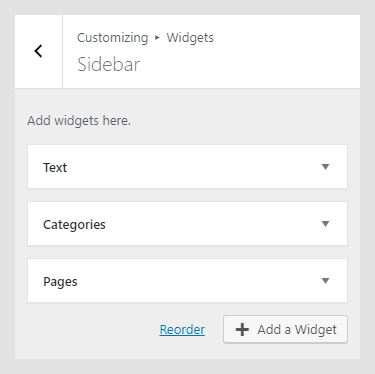
Widgets are useful extensions for content, which you can add to your sidebar or other widget areas. In the Widgets option in the Customizer, you can see available widgets area in the currently active theme.
Bottega theme has the top widget area, which is triggered by clicking on the button.
Homepage Settings
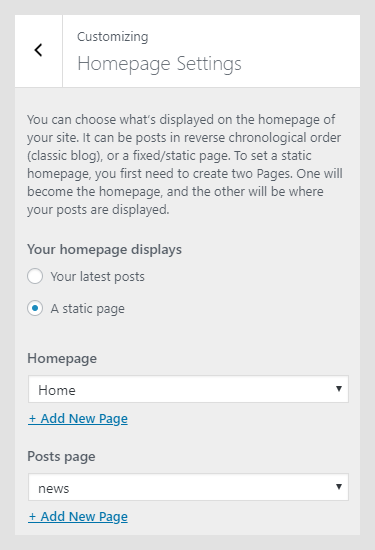
Homepage Settings in the Bottega WordPress theme documentation work the same way Reading settings in Settings -> Reading does. Homepage settings allow you to set the theme to use the static homepage or to display the latest posts.
Featured Content
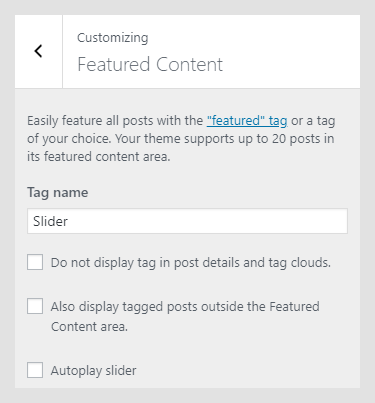
Featured Content can be used to set tag that is used for the projects to display them as the slider on the homepage. The Slider can display up to 20 slides.
- Tag name: Enter the tag name that you have used for the portfolio items that you wish to appear on the homepage.
- Do not display the tag in post details and tag clouds: If enabled, the tag used for the slider will not be displayed anywhere.
- Also, display tagged posts outside the Featured Content area: If enabled, portfolio items tagged with the tag used for the slider will be displayed on the page with portfolio template, as well.
- Autoplay slider: If enabled, the slider will automatically play slides.
- Show slide numeration: If enabled, the slide number will be displayed on the side.
Setting up a slider
To set up the slider in the Bottega WordPress theme documentation, follow these steps:
- In Pages -> Add New create a new page with title e.g. Home, and for the page template, select the Default template.
- Go to Settings -> Reading. Select the homepage to display a static page. For Homepage set previously created page.
- Go to Portfolio -> Add New. Create several portfolio items. For each portfolio item enter the title, and set featured image. Tag the desired portfolio items with the same tag e.g. Featured. The Tag will be used to identify and display the desired portfolio items as a slider.
- Finally, go to Appearance -> Customize, and under Home Slider Options -> Slider – Featured Content enter the tag used for the portfolio items.
Bottega WordPress theme documentation, step 6: Additional CSS
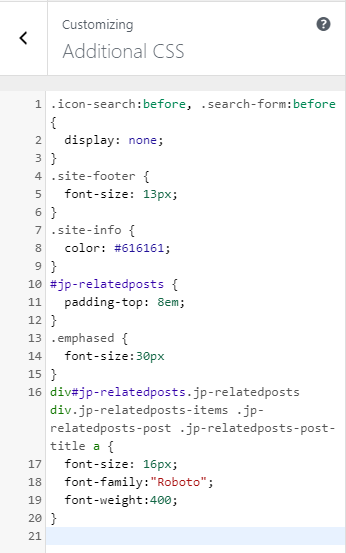
The Additional CSS section in the Bottega WordPress theme documentation is used for custom CSS classes, without interfering with the theme original CSS files, or creating a child theme. These classes are always loaded first, before other stylesheets. In the Useful CSS Classes section, you can find some most used classes.
Theme Options

Theme Options panel contains theme-specific settings.
- Footer Settings
- Header Settings
- Layout Settings
Footer Settings
 Footer Copyright Text: Text that will be displayed in the footer, as footer credits. You can enter basic HTML elements to create links and stylize footer text.
Footer Copyright Text: Text that will be displayed in the footer, as footer credits. You can enter basic HTML elements to create links and stylize footer text.
Header Settings
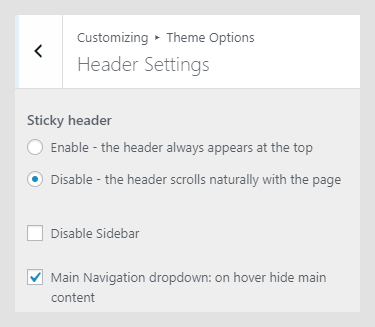
In the Header Settings of the Bottega WordPress theme documentation, you can set theme header behavior. Here, you can enable or disable sticky header, and disable sidebar (widgets area) trigger. Main Navigation dropdown: on hover hide main content option is used to display portfolio featured image over the whole site when hovering over the menu item.
Layout Settings

Layout Settings are used to define layout on the single post page and on the archive pages.
-
- Blog Post Single: Display media in a separate block will extract all media files (images and videos) from your single post and, on the single post, the text will be displayed in the left column, while media will be displayed in the right, scrollable, column.
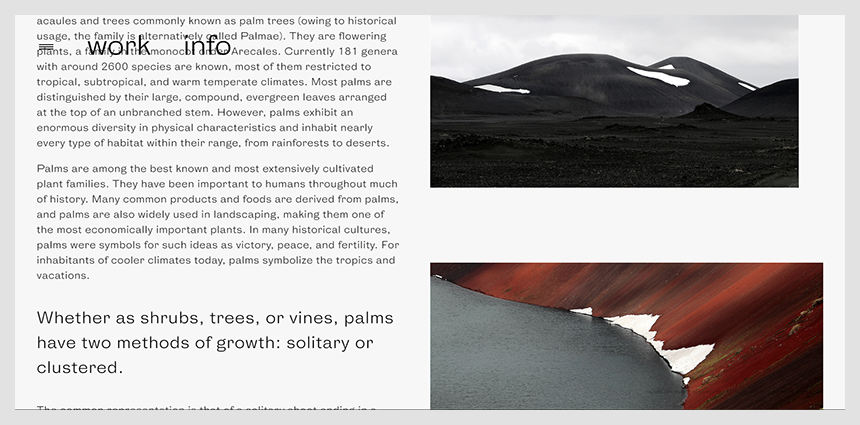
Images in a single media block. - Portfolio Archive: Display the title instead of the cursor (on hover): The project title can be displayed on the portfolio image instead of the cursor, and it will follow the mouse pointer movement inside the portfolio image.
- Portfolio Single Post: remove slide counter: If you have more images in your portfolio item, the number of images will be hidden.
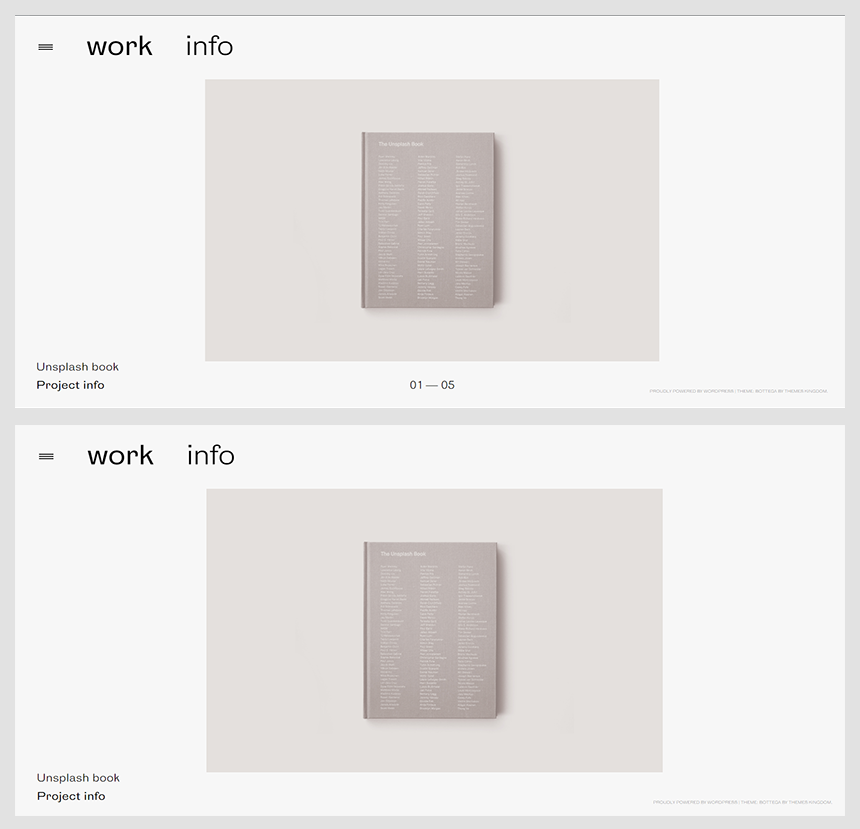
Single portfolio slider numbers turned on and off. - Show form buttons with animated arrows and without borders: This setting applies only to the Jetpack form. If checked, the Submit button will be displayed as an animated arrow.
- Blog Post Single: Display media in a separate block will extract all media files (images and videos) from your single post and, on the single post, the text will be displayed in the left column, while media will be displayed in the right, scrollable, column.
Bottega WordPress theme documentation, step 7: Useful CSS classes
Custom CSS classes can be added to the Additional CSS section in the Customizer.
Making image show on hover over the word
In our demo, on the About page, the artist’s image will pop-up when you hover over their name. To create that effect, insert an HTML block, and add code like this:

So, it’s important to wrap the desired word and image into element with the class “hoverimage”. That way, the word will become show trigger for that image.
Remove main menu stroke on hover – replace #000 with the desired color hex value.
@media only screen and (min-width: 1025px) {
.site-header nav a:hover, .site-header nav a:focus {
-moz-text-fill-color: #000;
-webkit-text-fill-color: #000;
-moz-text-stroke-color: transparent;
-webkit-text-stroke-color: transparent;
-moz-text-stroke-width: 0;
-webkit-text-stroke-width: 0;
}
}
Change single post title size
.single-post header h1.entry-title {
font-size: 48px;
}
Change single post content text size
.single-post .entry-content p {
font-size: 14px;
}
